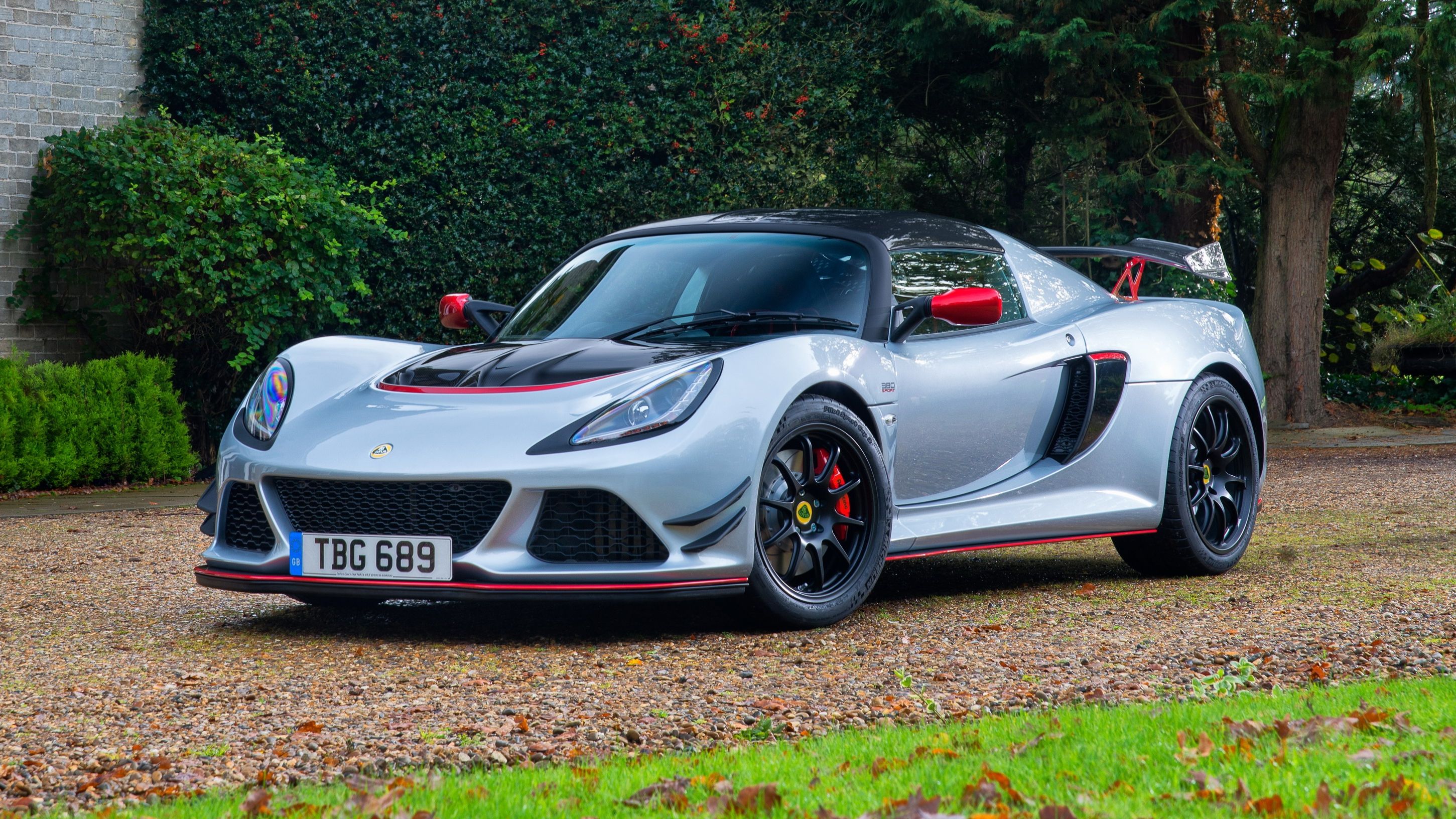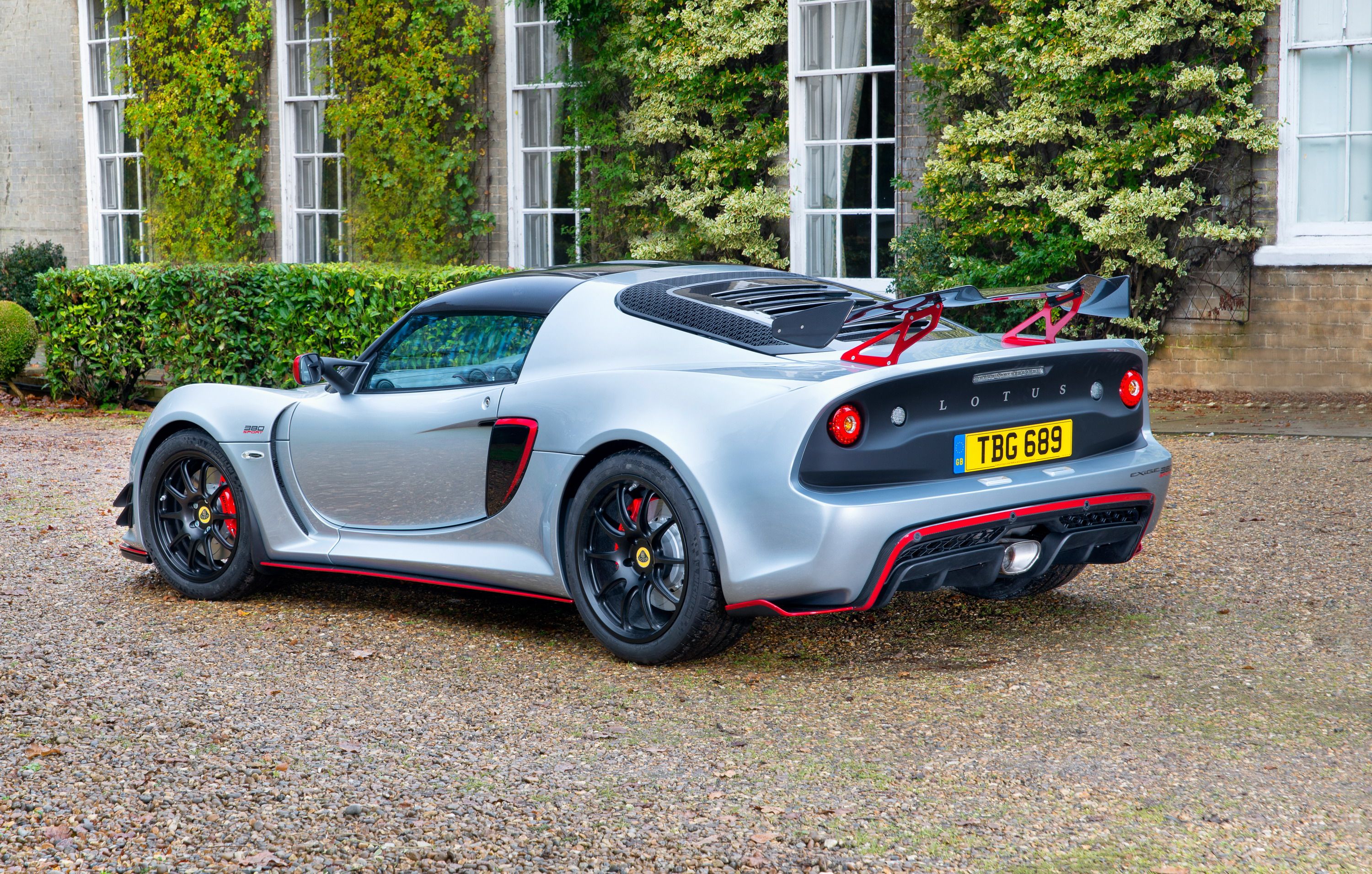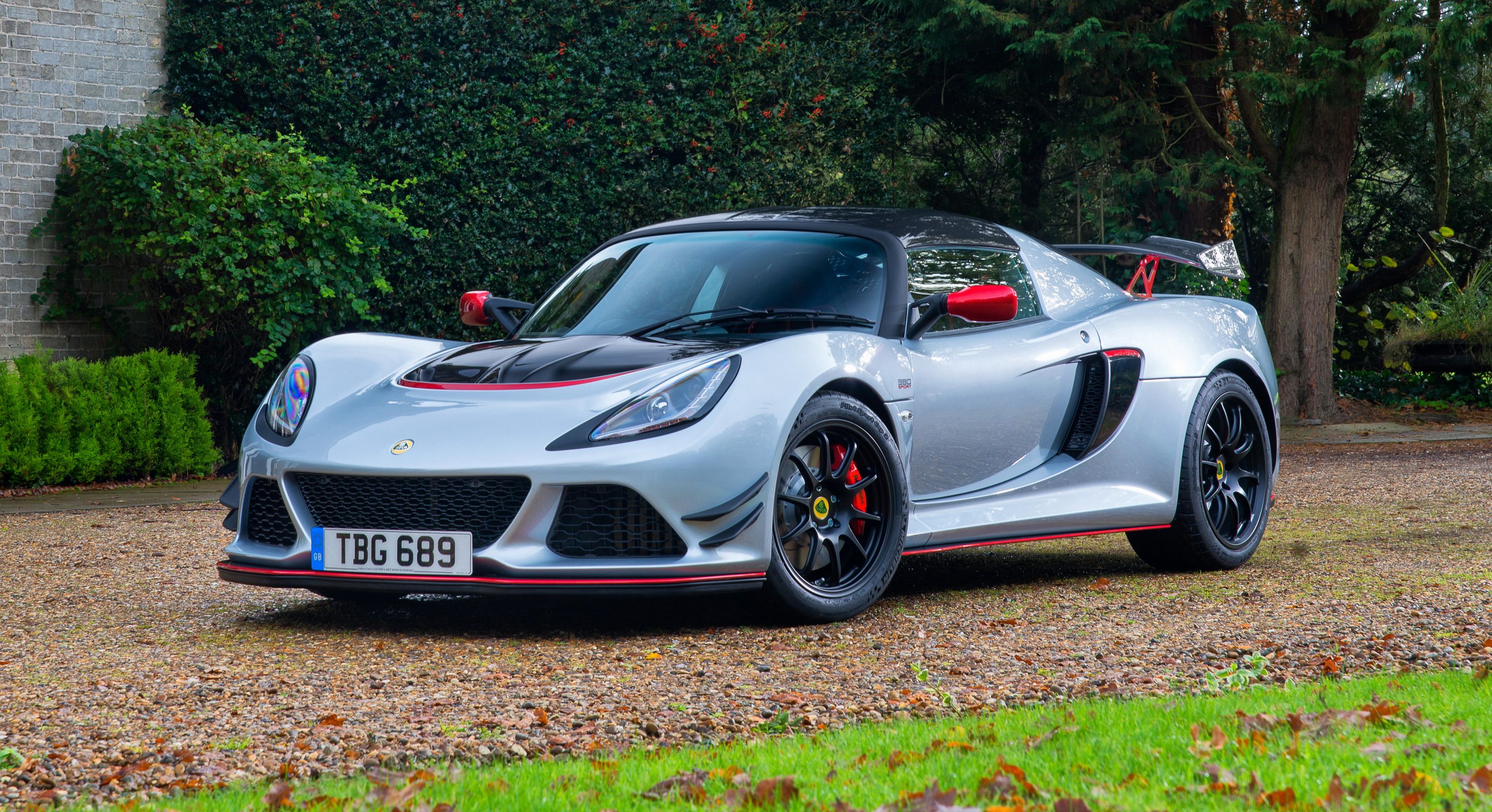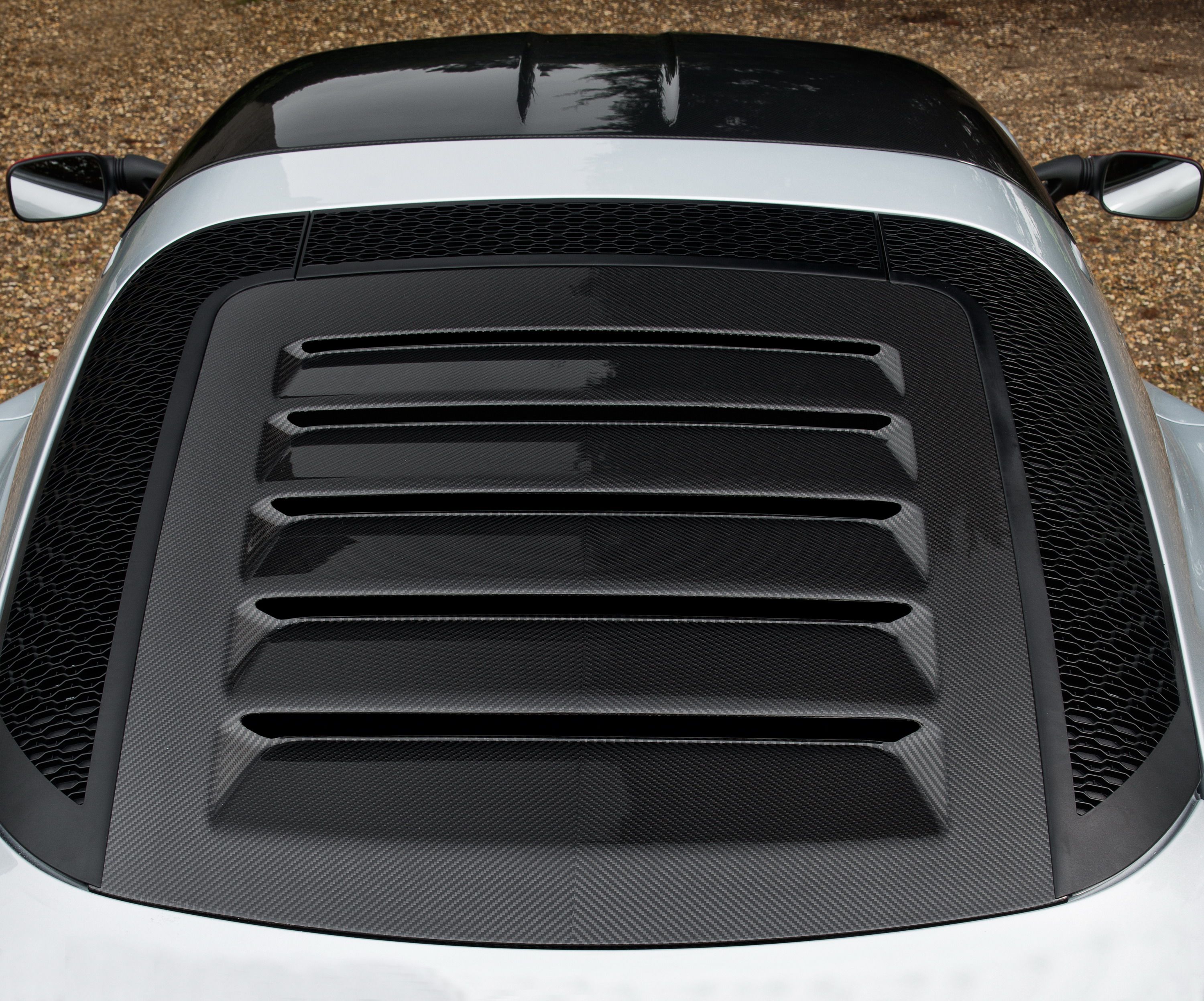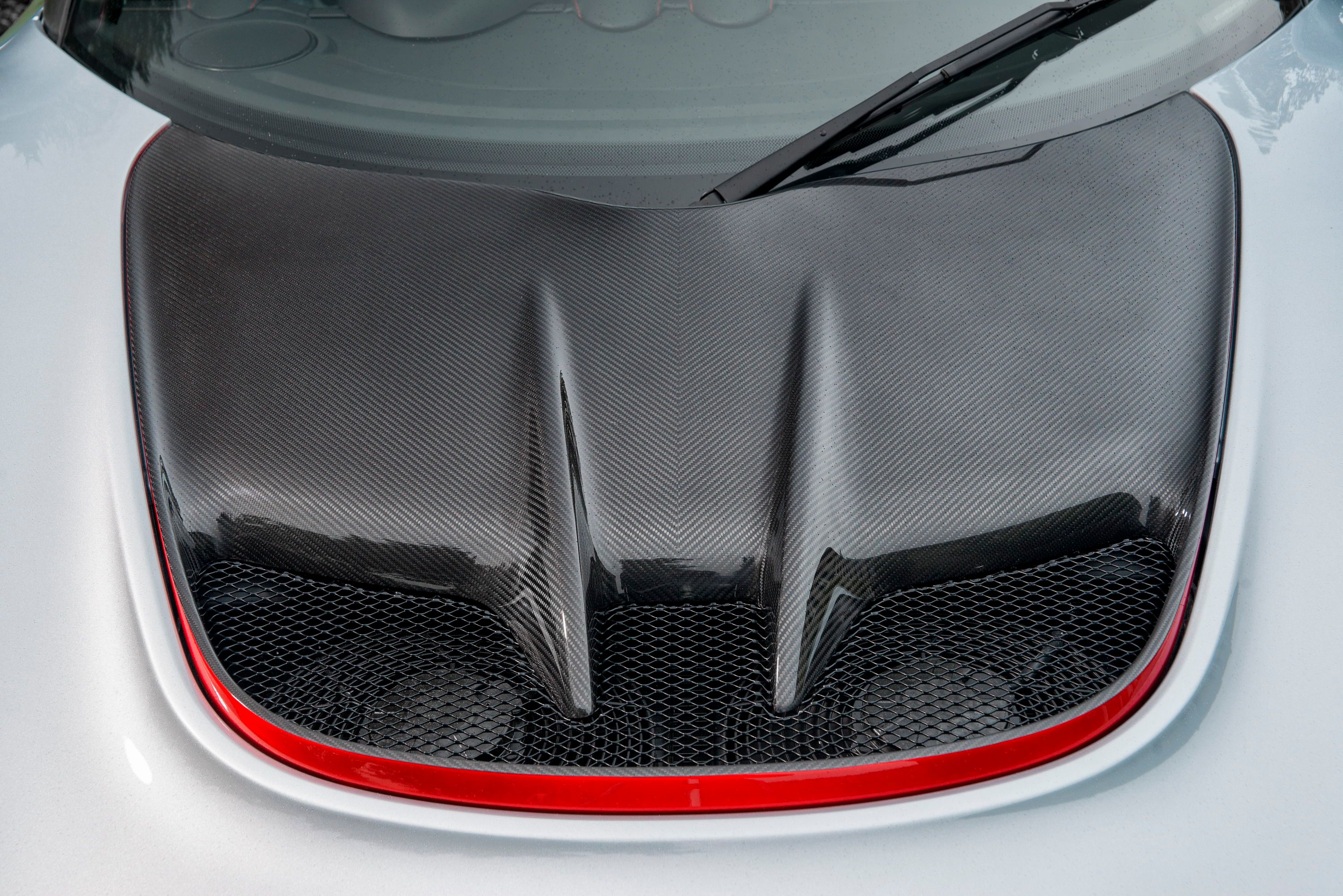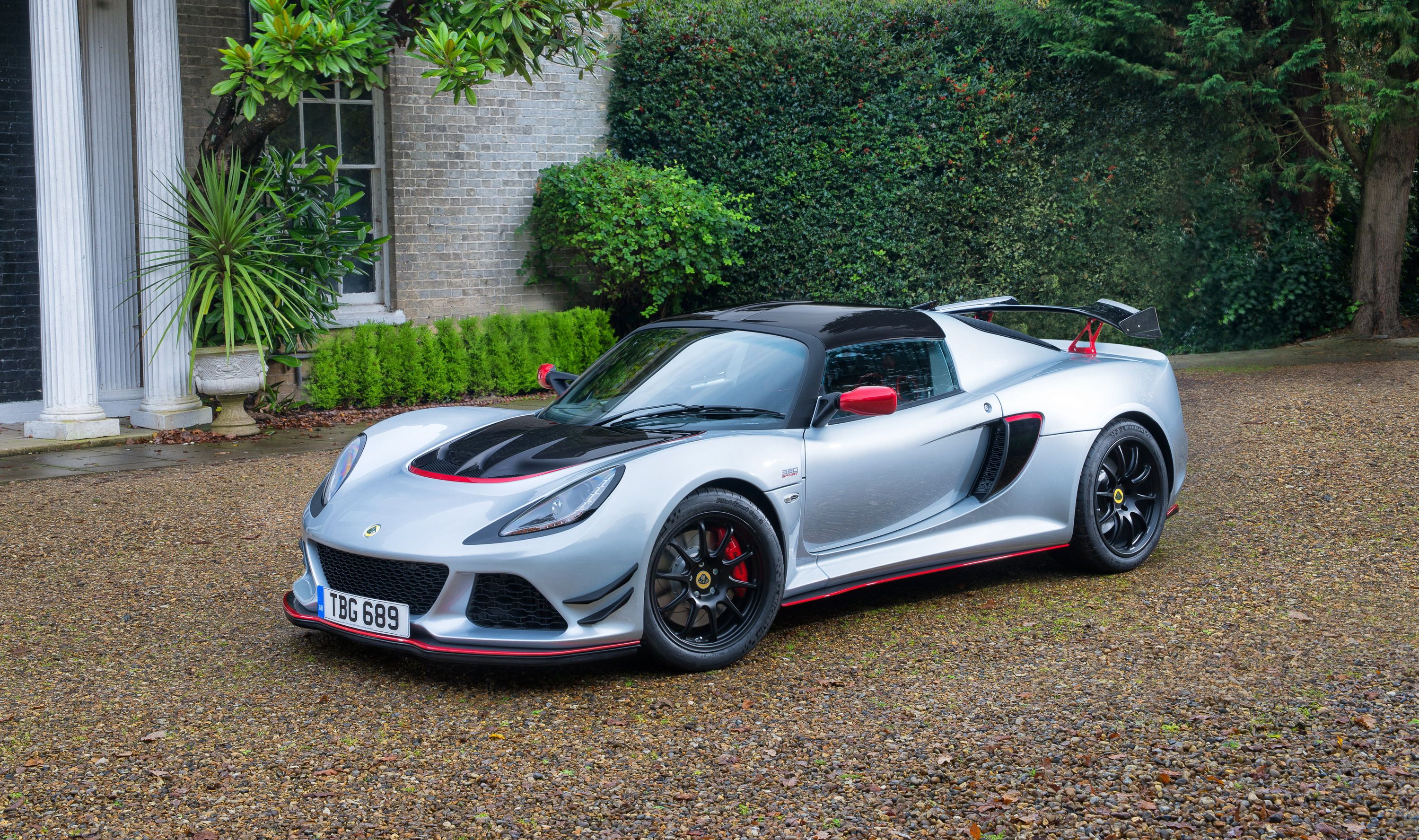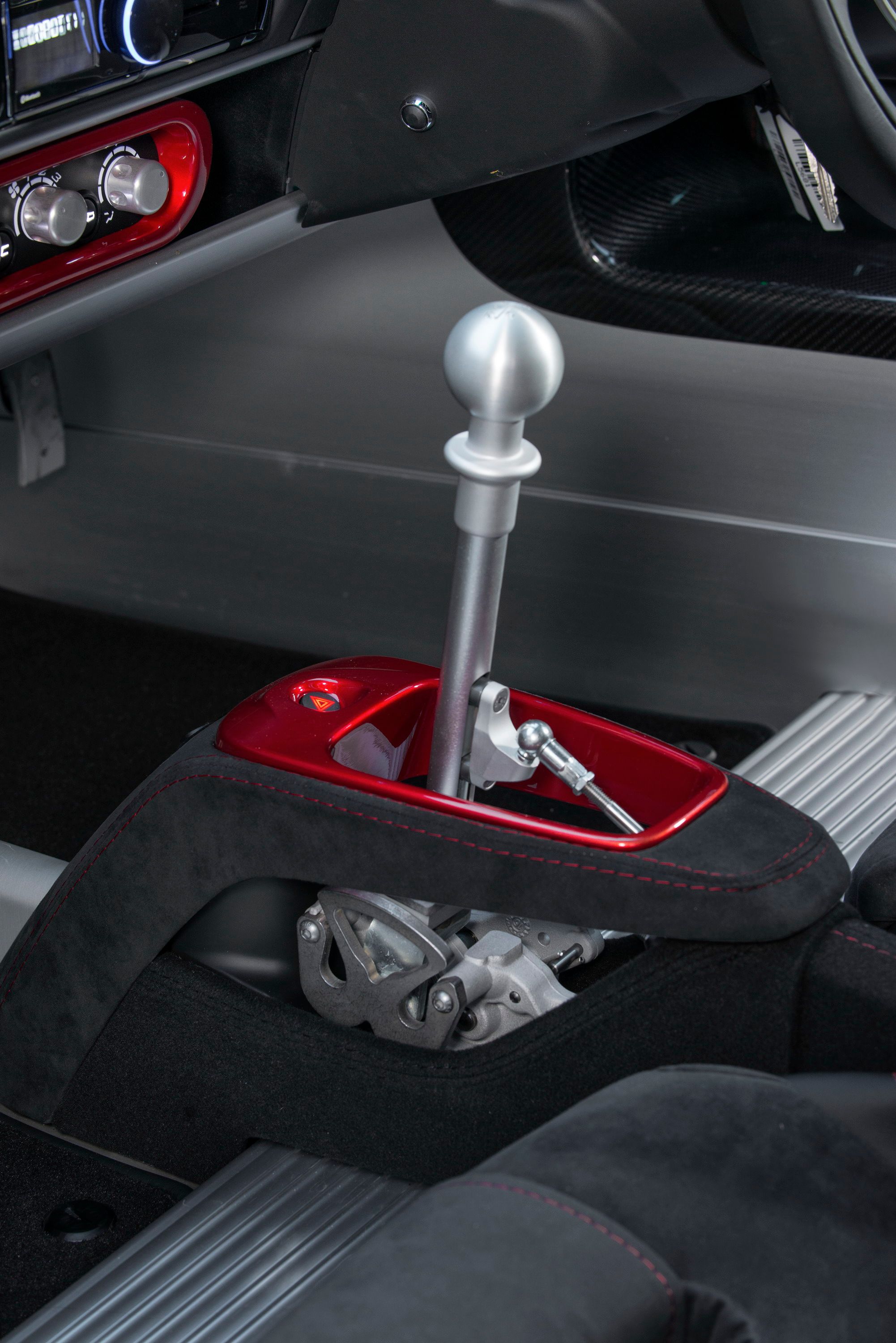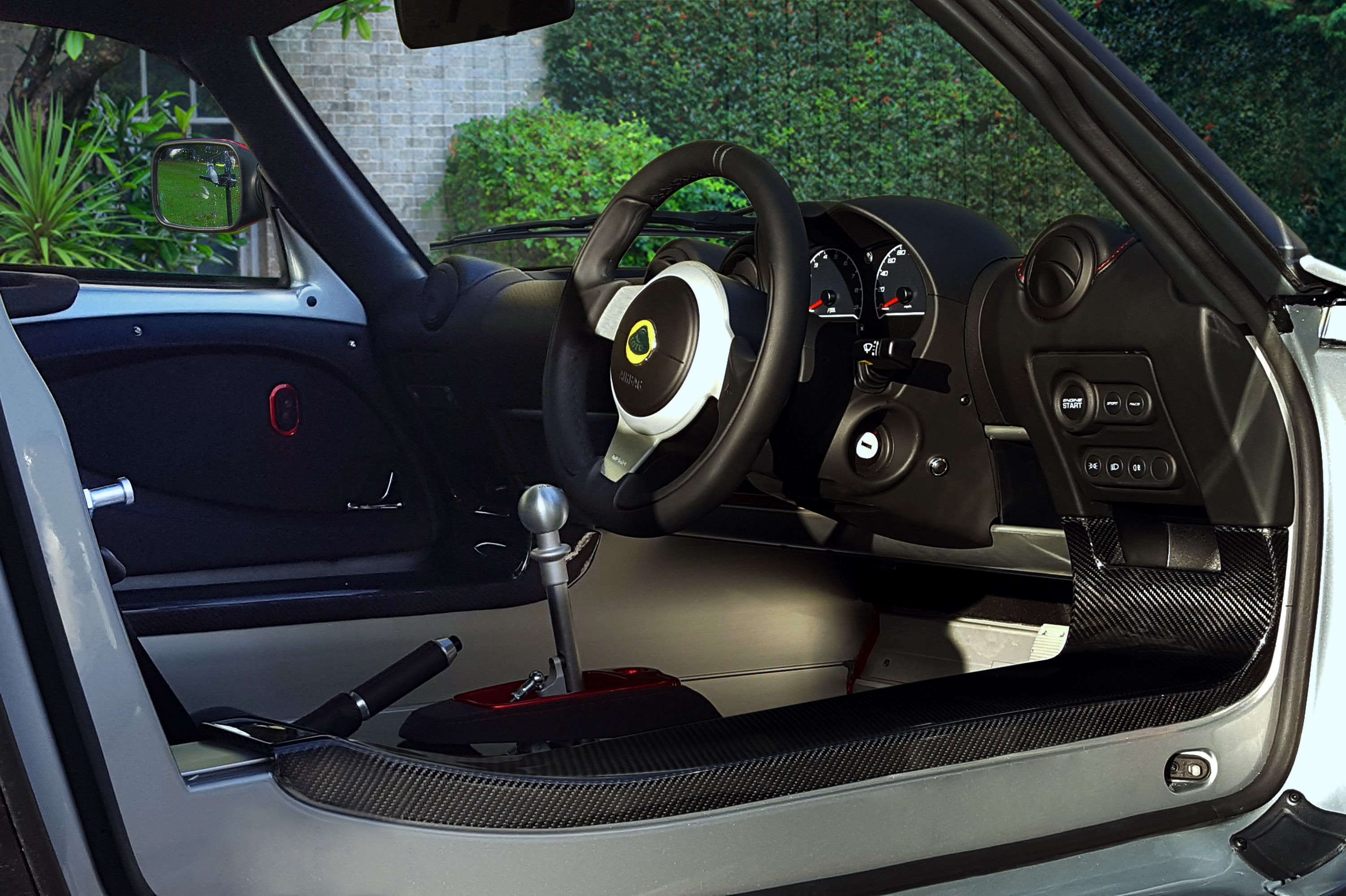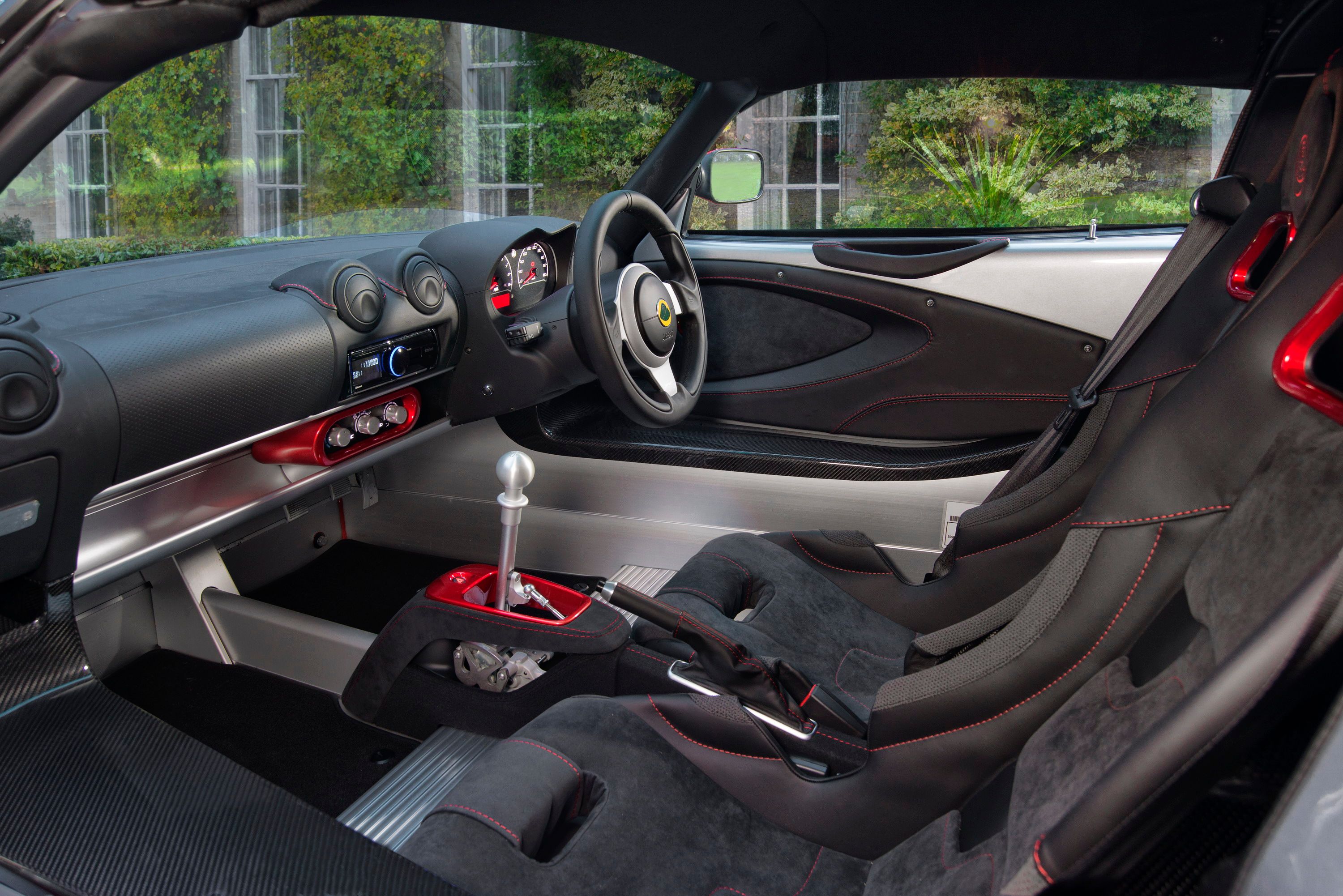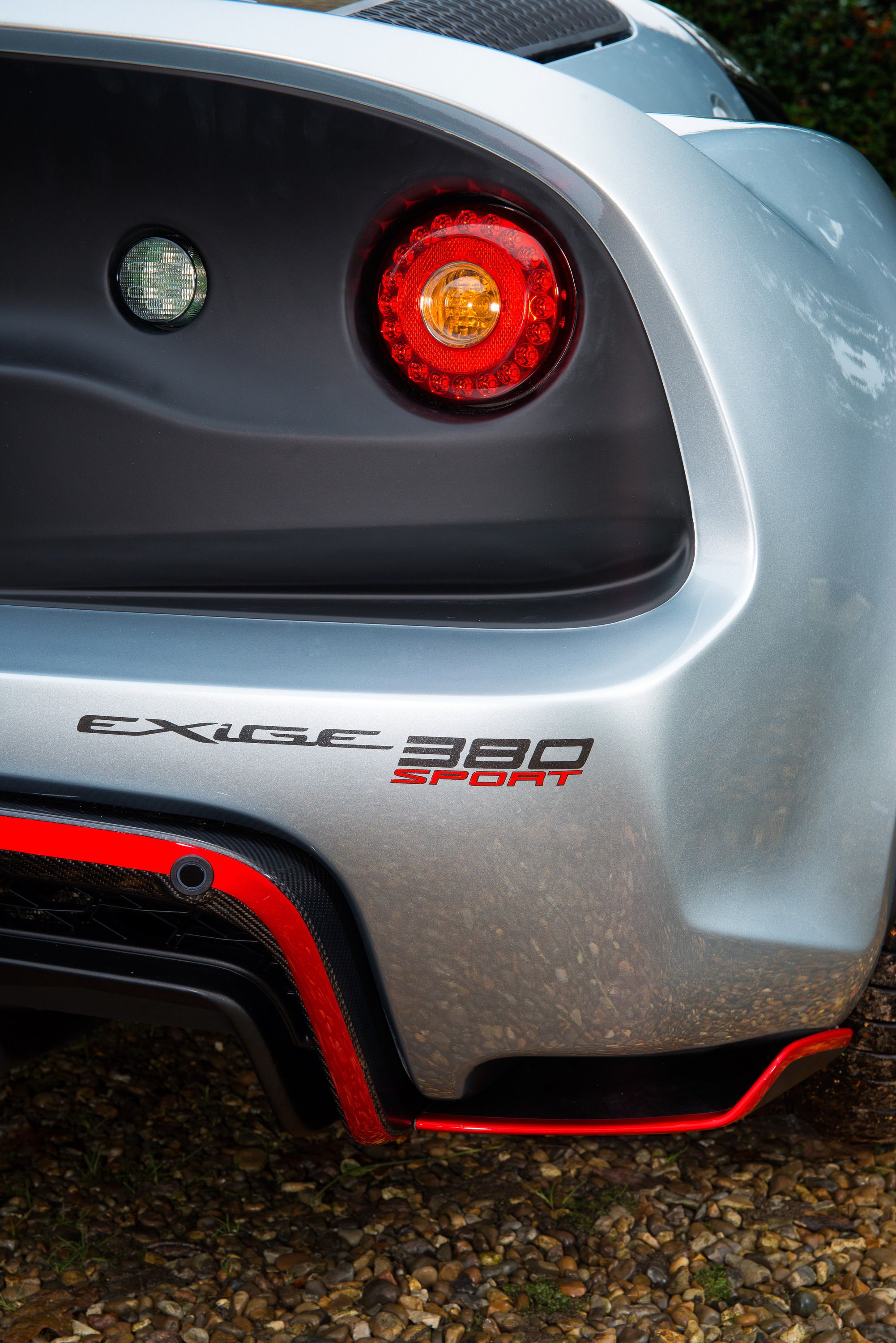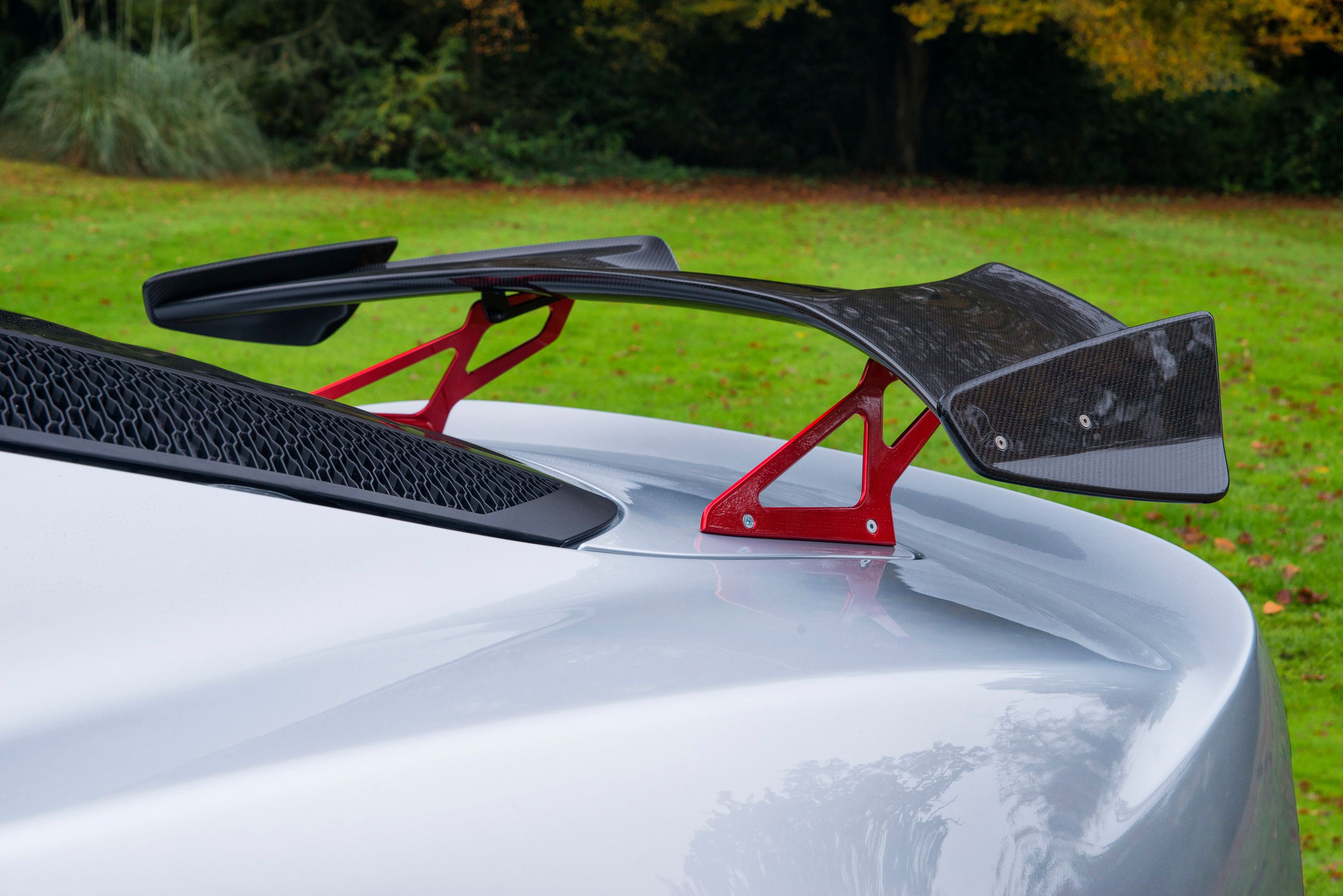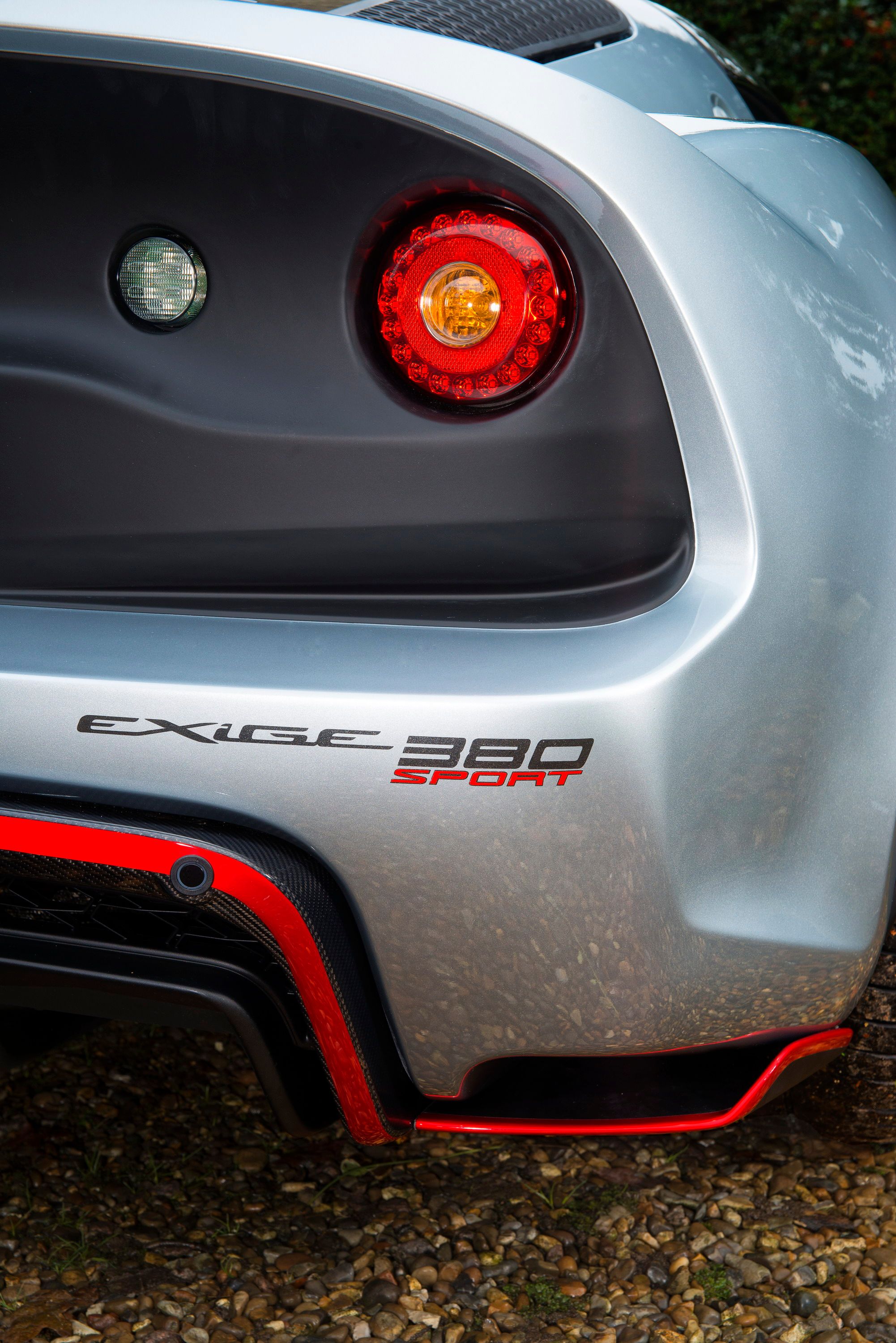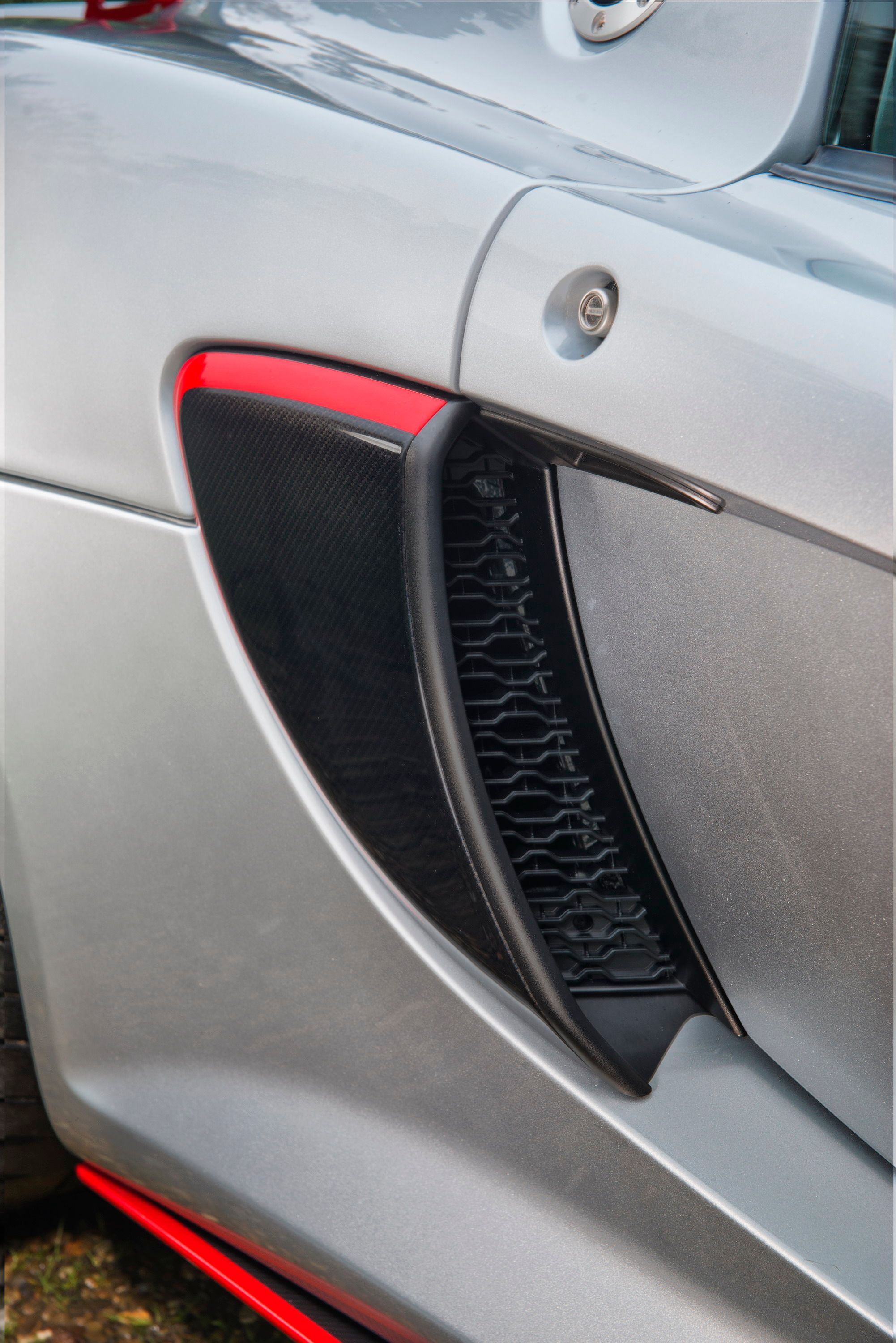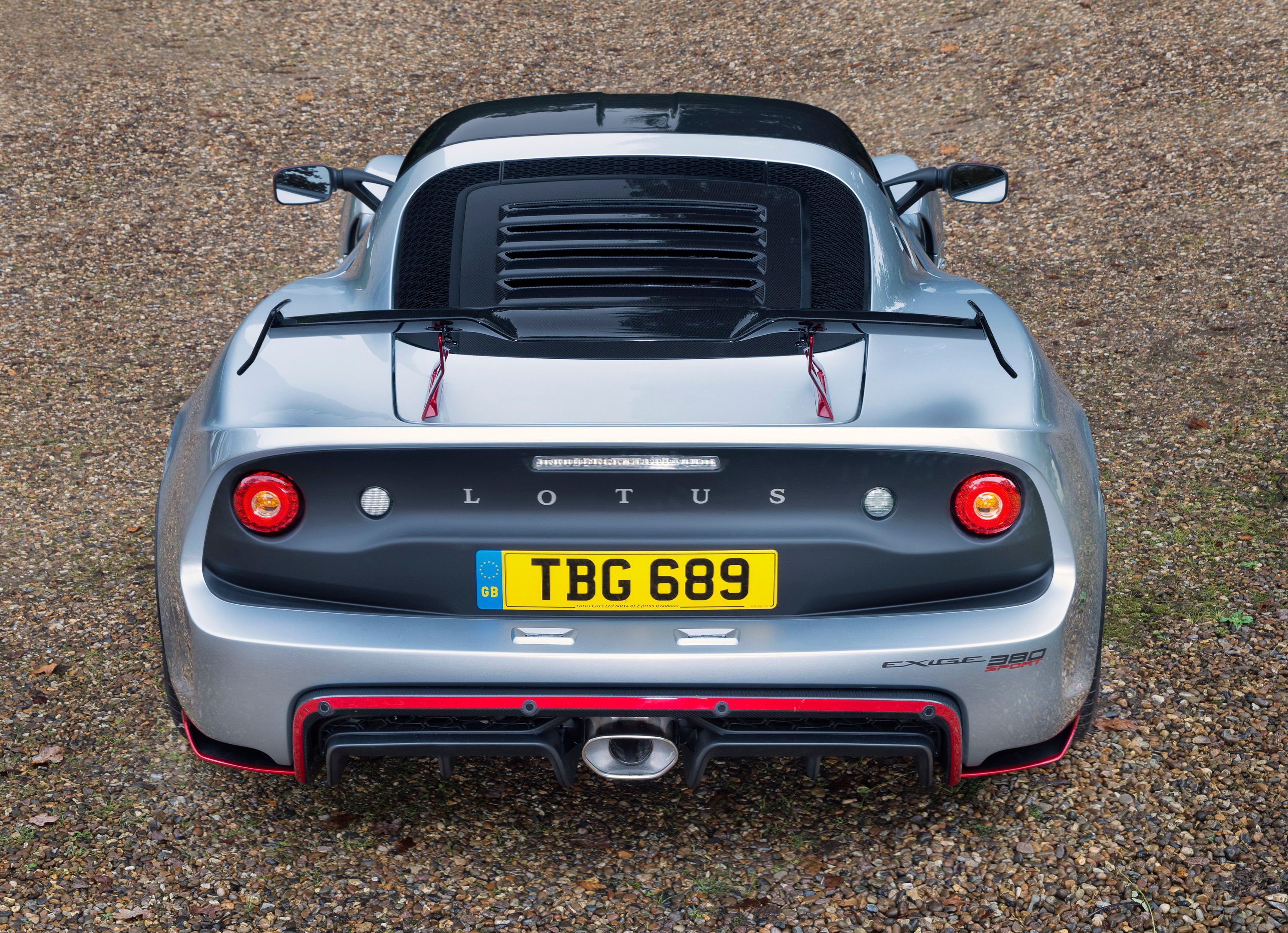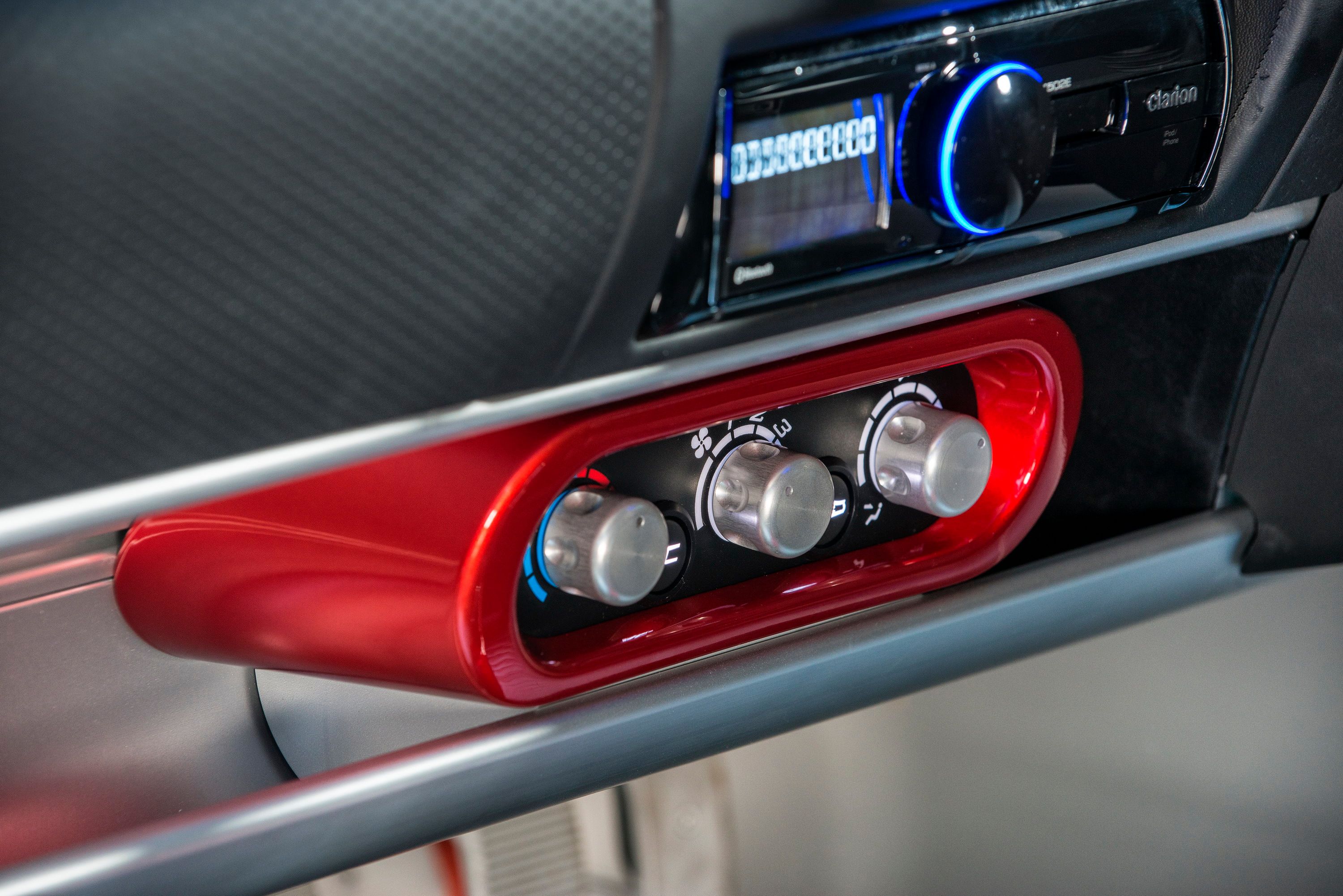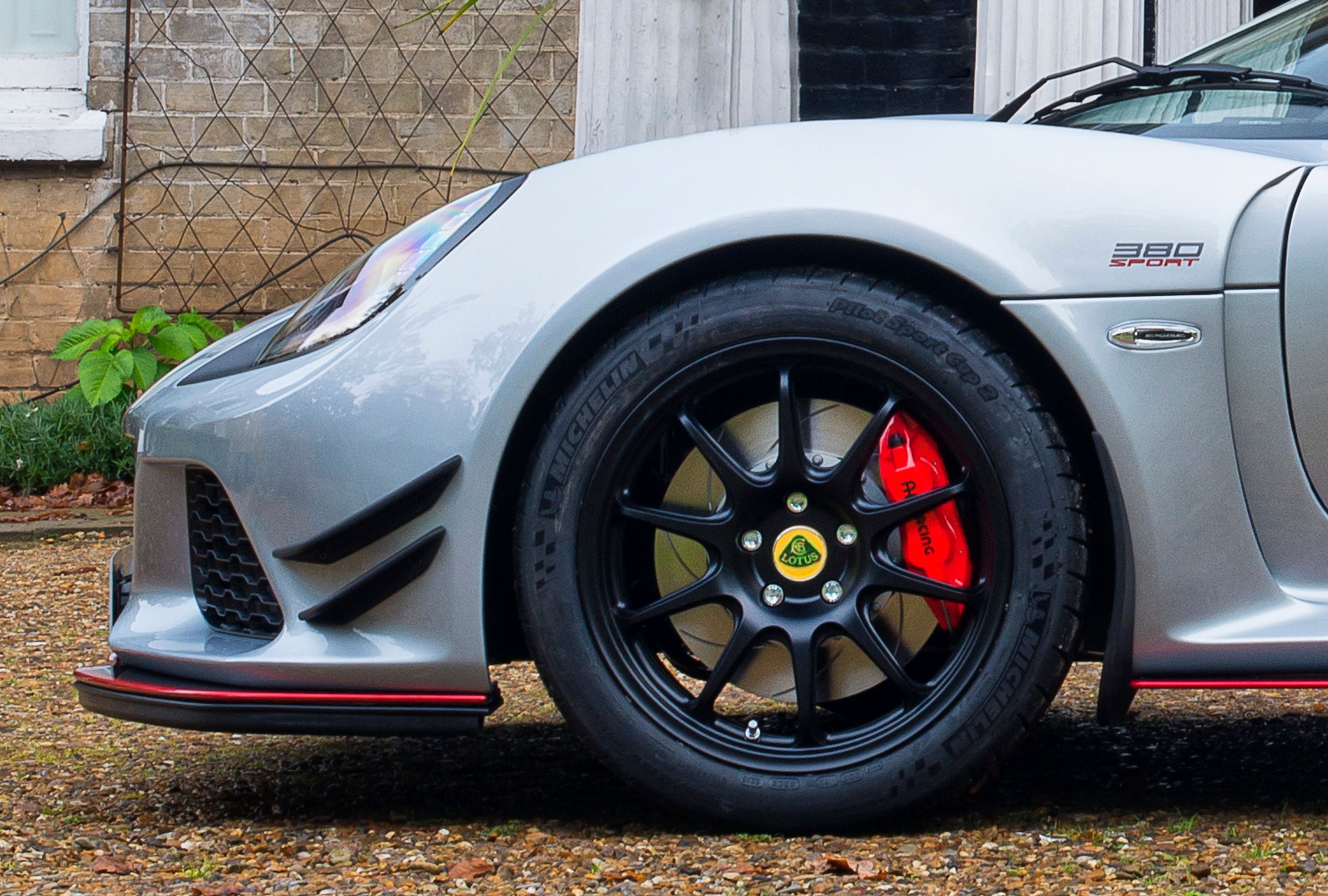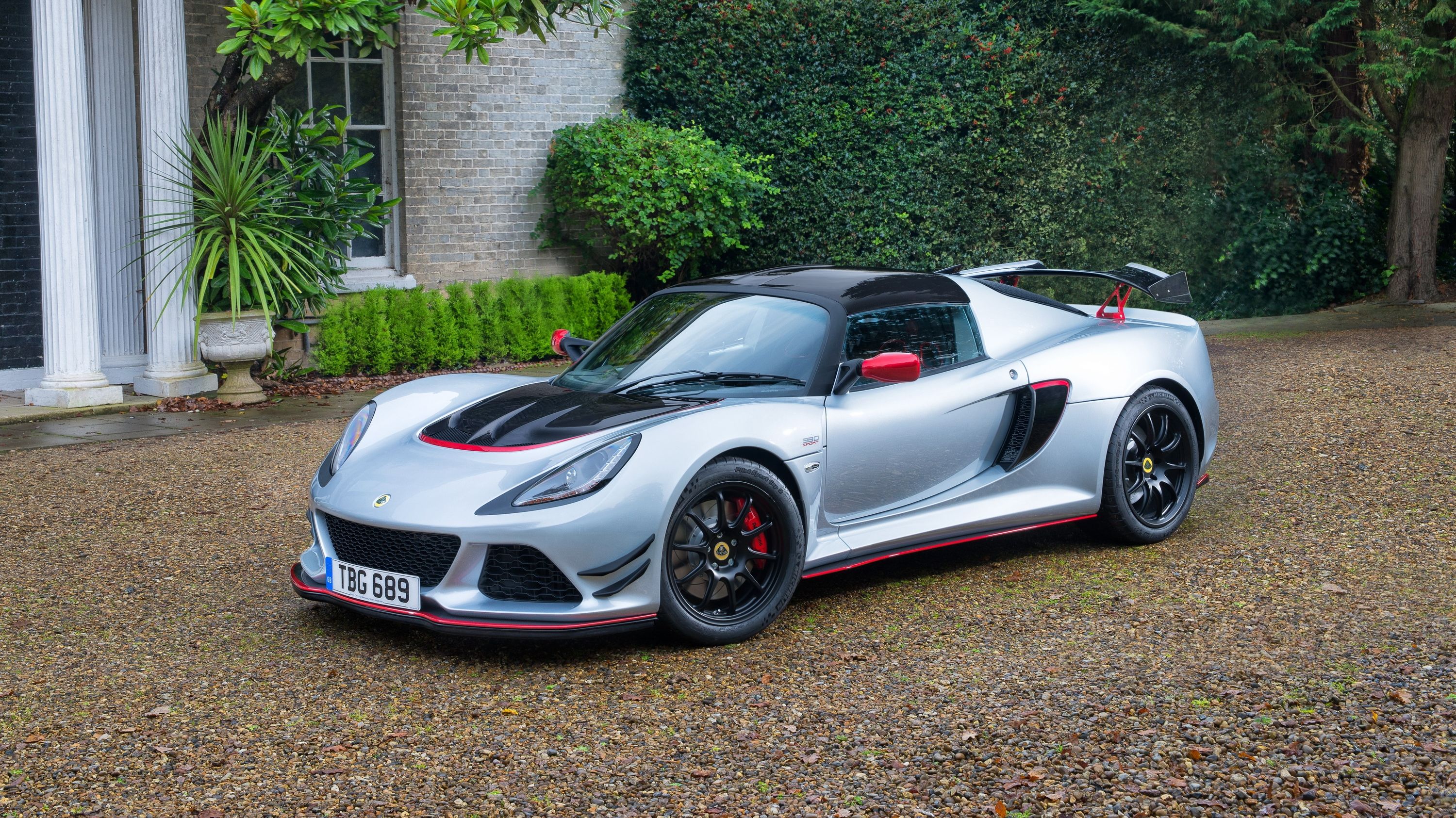Lotus was undergoing a bit a crises when its current CEO, Jean-Marc Gales, came onboard in 2014. But after spending nearly forty years in the red, the British brand is back in the black and doing what it does best – making lightweight sports cars for adrenaline-hungry enthusiasts. And that’s very good news indeed, because it means we get machines like this – the Exige Sport 380. Framed as a follow-up to the Sport 350 unveiled late last year, the 380 takes the tried-and-true Exige formula to even greater heights, making for the lightest, most powerful, most downforce-generating, and flat-out fastest model to ever wear the nameplate since it was first introduced in the year 2000. Offered as either a coupe or a roadster, this new range-topper is a bona fide street-legal track terror, packed with OCD weight saving details and legendary handling refinement.
Lotus claims the 380 is aimed at “six-figure supercars,” and looking at the spec sheet, it certainly appears to have all the trappings of a giant slayer.
“We’ve saved something special for our last new car of 2016,” says Gales. “We have built upon the foundations of the excellent Exige Sport 350 and developed a perfectly proportioned, intuitive and attainable supercar for real roads. The cut in weight is drastic and, combined with the hike in power and its enhanced agility, we’ve created something exceptional – far greater than the sum of its parts.”
For the moment, there’s no official word as to whether or not the 380 will come stateside, but if I were to guess, it’s unlikely. That said, Lotus has expressed interest in redoubling its efforts in North America, so maybe there’s a chance yet.
Either way, this is a car that pays attention to the details, so let’s do the same, shall we?
Continue reading to learn more about the Lotus Exige Sport 380.
2017 Lotus Exige Sport 380
- Make: Array
- Model: 2017 Lotus Exige Sport 380
- [do not use] Vehicle Model: Array
Exterior
Overall, the look of the 380 isn’t terribly different from that of the Sport 350. The same basic shape is unchanged, with an ultra-wide, ultra-low stance, high fender flares, large side intakes mounted behind the doors, and pointy creases front to back. The roofline falls gracefully into the rear end, and the tail gets a flat, truncated appearance that pushes the whole thing forward with a sporty, aggressive demeanor. While the dimensions are small, the shape is pure exotic head-turner, offering huge curb appeal no matter where it might turn up.
However, the 380 adds to this superb canvas with a slew of visual touches that simply scream for more attention. In front, the fascia gains new black headlight surrounds, while in the rear, the taillights go from a cluster of four to a cluster of two. The aero is beefed up with extra canards in front and a GT-style wing in back (more on that later), while details in the undertray, side-view mirrors, front access panel (the black section just ahead of the windshield), side intakes, spoiler risers, and rear diffuser are all striped in red. Raw black carbon pervades throughout.
You’d be forgiven for calling it over the top. But here’s the kicker – functionality was still Lotus’ primary goal. Step one – less weight. Enter everyone’s favorite composite material.
As you can see, carbon fiber is used everywhere on this thing, especially when it comes to the new aerodynamics. The new front splitter, reshaped access panel, bumper-mounted canards, large rear wing, and rear diffuser surround are all made from the stuff, cutting out 2.7 kg (roughly 6 pounds).
Seem a bit extreme? Well, get used to it, because we’re only scratching the surface.
In back, the glass rear window was replaced with a new polycarbonate unit (basically plastic), saving 0.9 kg (roughly 2 pounds) compared to the 350. And you know those new lamp clusters fixed to the rear? Well, those are for weight savings as well, simplifying the old four-cluster design to a two-cluster with inboard reverse lights and fog lights, netting another 0.3 kg (0.66 pounds) on the scales.
Obsessive? You bet. But that’s the Lotus way. We’ll explore further weight savings measures later in the review, but for now, expect the same basic theme – if you shave just a little bit from everywhere, the result is substantial, especially if you start with something as lightweight as the Exige Sport 350.
On to the aero. To keep the 380 as planted as possible while on the move, Lotus applied a good bit of updated CFD (computational fluid dynamics) modeling to the car’s design. This included tweaks to the front access panel for better airflow through the horizontally mounted radiators, improving the air’s movement across the top of the car, as well as an updated front splitter and lip spoiler design for reduced undercar pressure. The carbon canards just ahead of the front wheels are also new, as are the airblades behind the rear wheels and that big GT wing bolted to the trunk.
The result is 140 kg (309 pounds) of downforce when traveling at the car’s top speed, an improvement of 60 percent compared to the 88 kg (194 pounds) of the old 350 model. The 380 also makes more downforce than the Porsche Cayman GT4 (220 pounds). Incredibly, the extra stick is paired with the same coefficient of drag as the 350.
The rollers are new, and come with an updated lightweight design. Sizing is staggered, measuring in at 17 inches in diameter at the front and 18 inches in diameter at the rear. You can get yours with either a black or silver finish, while exterior paint choices include 10 different hues.
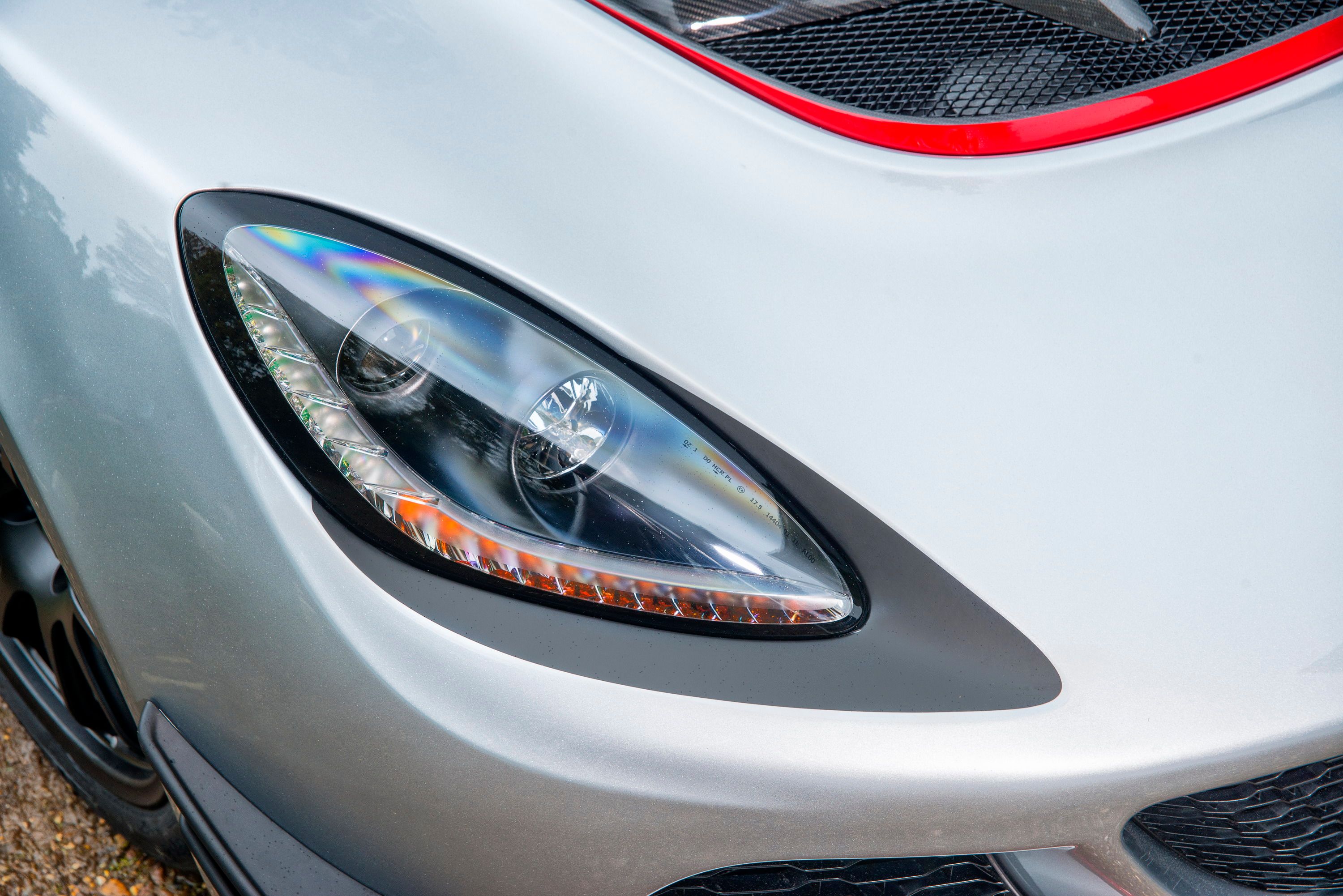
|
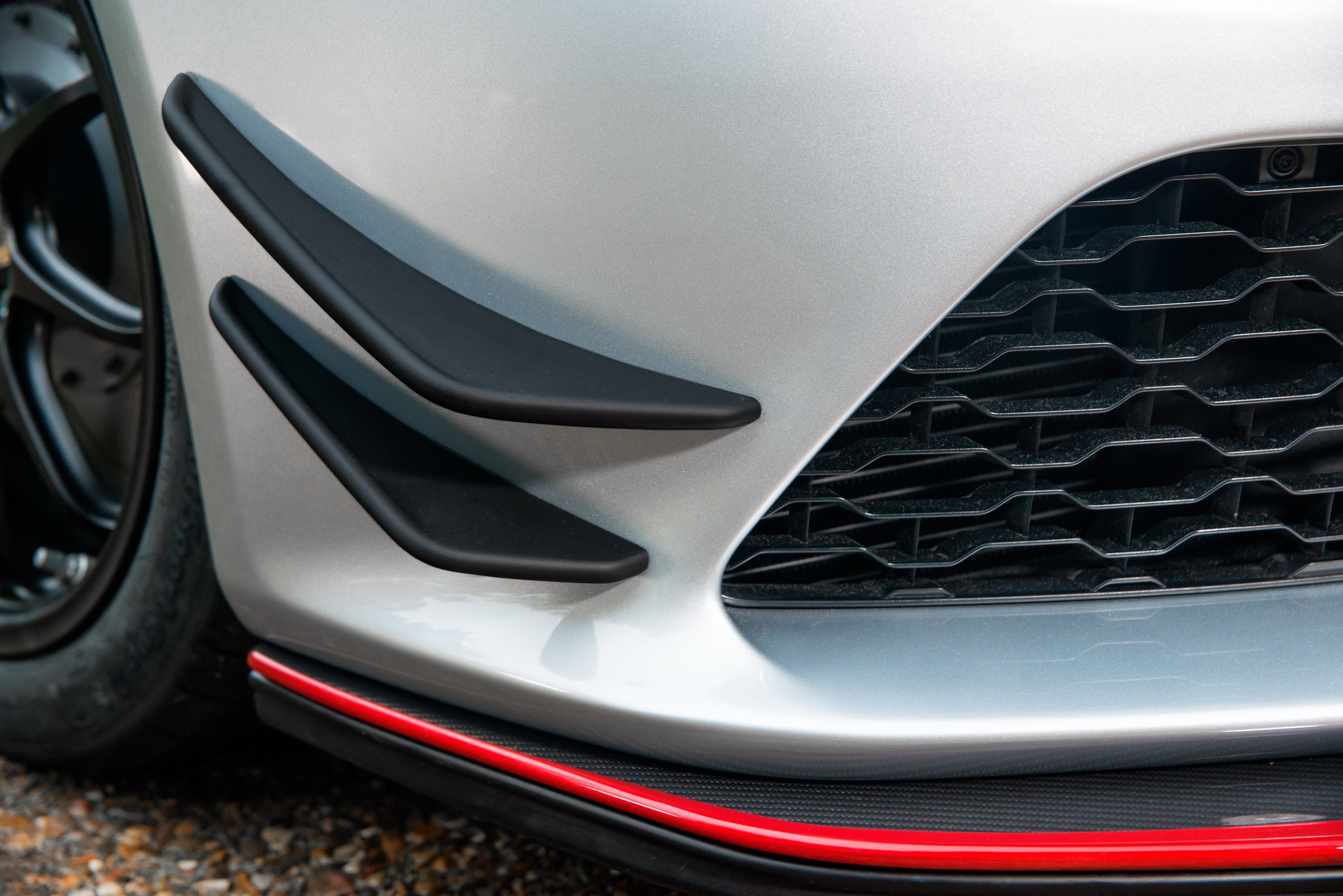
|
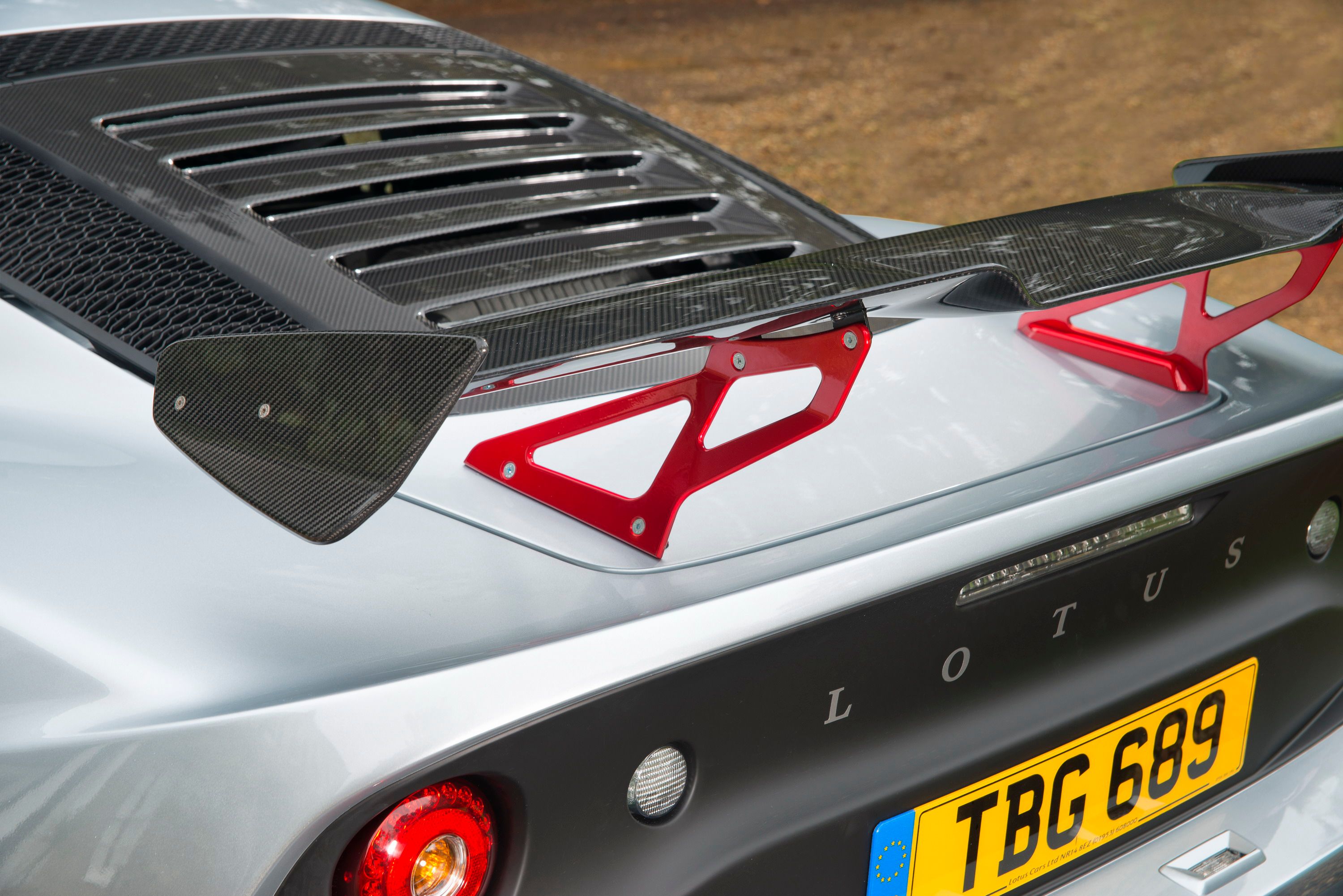
|
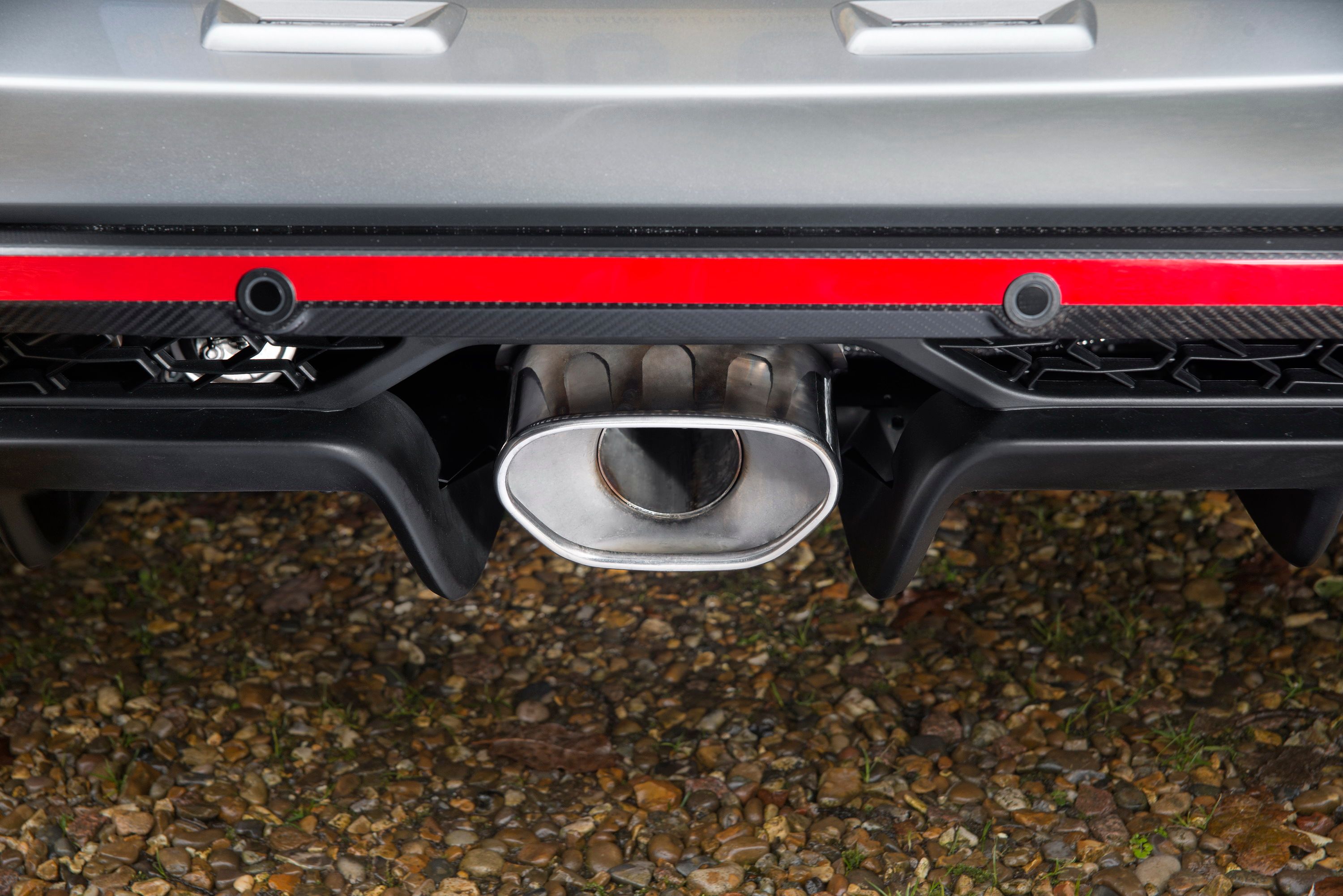
|
Further custom options include an exterior accent package with five different color choices. There’s also an optional Carbon Exterior Pack, which throws in a one-piece carbon roof panel and carbon louvered tailgate. Funny enough, the carbon roof is 2 kg (4.4 pounds) heavier than the standard roof, but the carbon tailgate is 2 kg lighter, which means a net-zero weight gain for the extra composite styling.
Finally, as mentioned previously, the Sport 380 will be produced either as a roadster or a coupe, with the droptop coming as standard and the hardtop offered as an available option.
Competition
Next to a rival like the Porsche Cayman GT4, the Exige Sport 380 could be seen as a bit ostentatious, especially with the bright red exterior trim and accents. Whereas the GT4 is refined in its approach to visual speed, the Lotus seems to shout, bearing a passing resemblance to some custom skin from a modern racing video game.
It’s a look that’s sure to appeal to plenty of enthusiasts, especially those that frequent the race track with any degree of regularity. However, for those folks who appreciate something a little more under the radar, the Porsche is the obvious way to go.
At the other end of the spectrum is the Atom. This is the car that famously melted Jeremy Clarkson’s face into a quivering mass of skin, and as such, it’s about as subtle as a racing kart with license plates. But that’s part of the appeal, right?
So where’s that leave the Sport 380? Well, somewhere in the middle. It’s a flashy head-turner for sure, but it’s not quite as shouty as some of its rivals.
|
Lotus Exige Sport 380 |
Porsche Cayman GT4 |
Ariel Atom 3 |
|
|
Wheelbase (Inches) |
93.30 |
97.8 |
92.32 |
|
Length (Inches) |
160.78 |
174.7 |
134.25 |
|
Width (Inches) |
70.94 |
71.5 |
70.78 |
|
Height (Inches) |
44.44 |
49.8 |
47.0 |
Interior
Per Lotus tradition, the Sport 380 is equipped with a barebones, spartan interior that’s heavily focused on melding car and driver into one cohesive unit. Amenities and features are as basic as they come, and the two-seater layout can be a tight squeeze for those of the larger, taller persuasion.
But while rudimentary in its design, the 380’s cabin does manage a sort of mechanical, analog, laid-bare appeal, something that’s not easy to find in the modern age of digitized automatic everything. The best example of this can be found on the central tunnel, where Lotus saw fit to install an exposed shift gear linkage, similar to what you get on the Sport 350.
Featuring an open-gate design, lightweight machined and cast aluminum components, and an anodized surround, this shifter is pure, unadulterated cool. It simultaneously looks both old and new, and hilariously, Lotus is quick to point out it saves a little weight as well. Exactly how much weight, you ask? Lotus doesn’t say, but my guess is it’s about the same as having two pieces of toast for breakfast, rather than three.
Speaking of weight, the 380 is outfitted with new carbon fiber racing buckets, which get fixed backs and come upholstered in either Alcantara, leather, or classic tartan fabric. Contrast stitching is thrown in as standard. While they certainly look rather snug, the 380’s seats also save 6 kg (13 pounds).
Options include carbon fiber side sill covers, which supposedly make it easier to get into and out of the car. I say sure, why not – this thing is so small and low to the ground, maybe a few millimeters actually do make a difference.
If you’re looking for a little more zest, there’s also an Interior Colour Pack, offering up four different contrasting hue options for the surrounds used on the transmission console, HVAC controls, seat eyelets, and electric window bezels.
There’s also a few options for the infotainment system, but to be honest, it’s more or less an afterthought for a car like this. Still, if you must, you can get iPod connectivity, Bluetooth support (a first for the model), and air conditioning.
Bluetooth and A/C? How opulent.
Further customization options can be had through the Lotus Exclusive program, which includes unique paint options, exterior graphics, interior trim, and more.
Competition
First things first – the optional infotainment system. The question is if it’s even really necessary in a car where every tenth of a kilo counts. Personally, I don’t think it is, but at least it’s an option that’ll broaden the 380’s appeal to folks considering this British two-door as a means of getting from A to B.
By comparison, the Porsche Cayman GT4’s cabin is a palace. The infotainment gear is modern and advanced, and there are soft-touch surfaces everywhere. If you want something that’ll coddle you a little on the way to a track day, Stuttgart is the way to go.
Then there’s the Atom. This thing has no doors and no roof. What’s that? You don’t wanna be chewing on bugs while cruising down the freeway? Well, you can get a windscreen, but it’s an option. ‘Nuff said.
and0}
In the old Exige Sport 350, there’s a mid-mounted, transverse, fuel-injected, 3.5-liter V-6 engine, which is the same powerplant you get in the Lotus 3-Eleven and Evora Sport 410. In the Sport 350, output is rated at 345 horsepower and 295 pound-feet of torque, all of which is sent to the rear wheels through a manual six-speed transmission.
As you might expect, those figures get a nice bump in the Sport 380. Lotus added a new supercharger pulley (read: more boost), a new fuel pump, a retuned ECU, and the same high-flow exhaust as the Evora 400 and Evora Sport 410, and the result is 375 horsepower at 6,700 rpm and 410 Nm (302 pound-feet) of torque at 5,000 rpm.
For those unwilling to break out the calculator, that’s a gain of 30 horsepower and 7 pound-feet, bringing the 380’s power-to-weight ratio up to 352 horsepower per metric ton (2,205 pounds), substantially improved next to the 350’s ratio of 307 horsepower per metric ton.
Acceleration improves as well, with the 0-to-60 mph sprint dropping two-tenths, going from 3.7 seconds in the 350, to 3.5 seconds in the 380. Top speed is upped by 8 mph, going from 170 mph in the 350, to 178 mph in the 380.
Complementing the extra muscle, Lotus also fiddled with the Exige’s transmission, modifying the old six-speed manual for quicker gear changes, plus adding a new oil cooler for higher performance. If you’re the kind of person who’s frightened by three pedals, Lotus is offering the option for a six-speed automatic, which throws in forged aluminum shift paddles on the steering wheel. And if you simply can’t be bothered, the slush box also gets a full auto mode. Availability for the automatic transmission opens up this coming Spring.
Finally, Lotus also added a bigger fuel tank, now up to 48 liters (12.7 gallons) from the 350’s old 40-liter (10.6-gallon) tank. It’s a bit of an unexpected move for a car like the Sport 380, considering the extra heft that a bigger tank filled with gasoline adds to the car’s weight, but I guess if it means more laps before pulling in for a refuel, it’s worth it.
Competition
If you’re looking to best the beast from Germany in the acceleration department, the Exige Sport 380 should fit the bill. While the Cayman GT4 is surely no slouch, boasting 385 horsepower thanks to its potent 3.8-liter flat-six engine, it’s still significantly slower in the 60-mph sprint, taking just over four ticks to reach that magic number. Top speed, however, is a bit higher, clocking in at a never-going-to-use-it 183 mph.
But if ultimate speed is more your thing, then the bomber from Ariel is the clear winner. Even if you opt for the much cheaper Atom 3 model, you’re still looking at 60 mph in a heart-stopping 2.9 seconds, all thanks to a high-strung, naturally aspirated 2.4-liter four-cylinder banging out 230 horsepower.
|
Lotus Exige Sport 380 |
Porsche Cayman GT4 |
Ariel Atom 3 |
|||
|
Lotus Exige Sport 380 |
Porsche Cayman GT4 |
Ariel Atom 3 |
3.5-liter V-6 |
3.8-liter DOHC 24-valve flat-6 |
2.4-liter Honda K24 i-VTEC |
|
Engine |
375 HP @ 6,700 RPM |
385 HP @ 7,400 RPM |
230 HP |
||
|
Horsepower |
302 LB-FT @ 5,000 RPM |
309 LB-FT @ 4,750 RPM |
|||
|
Torque |
six-speed manual |
six-speed manual |
6-speed with a limited slip differential |
||
|
Transmission |
3.5 seconds |
4.1 seconds |
2.9 seconds |
||
|
0 to 60 mph |
178 mph |
183 mph |
|||
|
Top Speed |
2,447 Lbs |
3,050 Lbs |
1,350 Lbs |
Chassis And Handling
So the Exige Sport 380 is quick – that much is obvious. But this thing is about so much more than straight-line potential. According to Lotus, the 380 also aims to be “sharper, and more direct than adversaries.”
To achieve it’s incredible performance, especially in the bends, the 380’s primary weapon is an absolutely feathery curb weight. As such, this new model uses several of the Sport 350’s lightweight components, including innovations from Lotus’ Lightweight Laboratory, and copious carbon fiber components glistening with an unpainted, high-gloss finish weave.
The bones of the machine are good as well, employing a lightweight bonded and extruded aluminum (erm, excuse me, aluminium) architecture. Adding to all those nitpicking weight-saving details listed above is a new lithium-ion battery, which cuts 10.3 kg (22.7 pounds), plus new forged wheels and grooved disc brakes that combine to cut a further 10 kg (22 pounds). There’s also an available titanium exhaust system that reduces weight over the rear axle, improving the car’s balance in the process.
Fine. So let’s stop beating around the bush then, shall we?
The Exige Sport 380 has a curb weight of 1,110 kg (2,447 pounds), or 1,121 kg (2,471 pounds) when equipped with an automatic transmission (yet another reason to go three pedals). Opt into the various diet options, and you’ll shave another 10 kg (22 pounds) or so.
That’s nearly 25 kg (55 pounds) less than the Sport 350, which is a noticeable amount of mass for a car at this size and weight. And I know if you add up all the weight savings mentioned in this article, it’s more than 25 kg. The 25-kg number is based on final weight figures published at Lotus’ website, so it looks like weight additions found their way in was well.
Lotus hasn’t specified the weight difference between the coupe and roadster models, but it should be noted that the 350 droptop is actually 10 kg (22 pounds) lighter than a similarly equipped hard top.
However you wanna look at it, the 380 is lighter than the 350. But the magic of a Lotus isn’t just about raw power-to-weight – it’s about the way the car manages when thrown at an apex or two.
Tested extensively on Lotus’ company track in Hethel, the 380 supposedly “offers a pure, undiluted drive that has to be experienced to be fully appreciated.” The focus is on old-school tuning techniques, rather than electronics that could “dull the experience” behind the wheel.
It all starts with fully independent double wishbone suspension in front and back, plus front and rear anti-roll bars. Bilstein makes the dampers, while Eibach makes the springs.
Minimal digital intervention is provided by the automaker’s Dynamic Performance Management system, or DPM. This comes with multiple modes for whatever the situation (or skill level) might call for, including “Drive,” “Sport,” and “Race.” Touch a button, and you get different settings for the throttle response, traction slippage, and “understeer recognition.” There’s also an exhaust bypass for even sharper response higher up in the rev range.
The steering is 100 percent manual and unassisted, a truly awesome feature for anyone looking for maximum feel.
Standard tire appointment is Michelin’s Pilot Sport Cup 2 tires, a streetable ultra-high performance compound also found on the Porsche 918 Spyder and Ferrari 458. Sizing is staggered at 215/45R17 in front, and 265/35R18 in back. The 380 gets tires that are 10 mm wider in front compared to the 350, which means more mechanical grip, and presumably, less understeer as well.
An electronic differential lock from Bosch makes even more traction when needed.
AP Racing makes the stoppers, with forged four-piston calipers and grooved two-piece discs, all of which is controlled thanks to a Lotus-tuned ABS system.
And for those who are really serious about wringing it out, Lotus is offering its Track Pack, which includes two-way adjustable dampers from Nitron, plus adjustable front and rear sway bars from Eibach.
Competition
Beating the best on the racetrack is one of Lotus’ specialties, but the Cayman GT4 won’t go out without a fight. The Porsche offers all kinds of high-performance goodies to keep pace, like a lightweight lithium-ion battery, ceramic composite brakes, an A/C delete, and the Sport Chrono Package with Track Precision App, but even with all these goodies installed and the bottom line seriously inflated, the Lotus will likely walk away lap after lap.
Conversely, the hardcore Atom is once again the one to get if what you want is a dedicated track car where every tenth counts. It’s both lighter and faster, plus it’s cheaper, which matters if you accidentally stuff it.
Prices
So far, Lotus has released the Exige Sport 380’s MSRP in three separate markets. For Lotus locals (that is, the British), pricing comes in at 67,900 pounds. The Germans will get it for 89,900 euros, while Japanese buyers can pick one up for 12,760,000 yen.
Long story short, the Exige Sport 380 is significantly more expensive than the Sport 350. To be exact, it’s 12,000 pounds more than its predecessor in the U.K, which is a sizable bump in price, even when considering all the upgrades you get with the 380.
Competition
Porsche Cayman GT4
Unveiled in February of 2015, the Cayman GT4 added yet another name to Porsche’s top-shelf GT family. Framed as a pure, unblemished vision of the ultimate performance Cayman, the GT4 follows in the footsteps of such greats as the 911 GT3, 911 GT1, and Carrera GT. It might be a bit slower than the Lotus, but don’t underestimate it – properly motivated, this thing can still lap the Nurburgring in 7 minutes, 40 seconds.
Read the full review here.
Ariel Atom
U.K.-based automaker Ariel introduced the appropriately named Atom in 2000, offering the world a glimpse at what could be done when barely streetable meets minimalism in the name of speed. This thing is as stripped down as they come, coming fitted with nothing more than what’s needed to absolutely destroy lap times. You can get yours in a variety of flavors, including the truly insane 500-horsepower Ariel V-8, but if you’re looking for something to run against the Lotus Exige Sport 380, go for the 3 or 3S model.
Read the full review here.
Conclusion
These days, the term “track-focused” is pretty much relative. It could mean something somewhat civilized, like the Porsche Cayman GT4, which concedes a bit of backside coddling and comfort on the way to exhilarating performance. Or, it could mean something brutal, like the Ariel Atom, which concedes nothing and seeks the finish line ahead of the pack above all else.
The Lotus Exige Sport 380 falls somewhere between these two examples. It’s stripped down and basic, but it won’t thrust you into the elements with too much enthusiasm.
But never forget – this thing is still wickedly fast. The attention to detail, the engineering, the refinement… this is a car that emphasizes the driving experience, the feeling of going fast, the reward of precisely placing your tires at an apex.
You can tell because the 380 is the polished Exige. Last time around, the automaker from Hethel was touting the Exige Sport 350 as the fastest and lightest to wear the nameplate, but now, Lotus is doing us one better – well, 30 better, to be exact. And the improvements are where it counts – power, aero, and weight. The 380 isn’t trying to do anything controversial. Rather, it’s doing what the Exige has always done, only better.
And that’s reason enough to celebrate.

